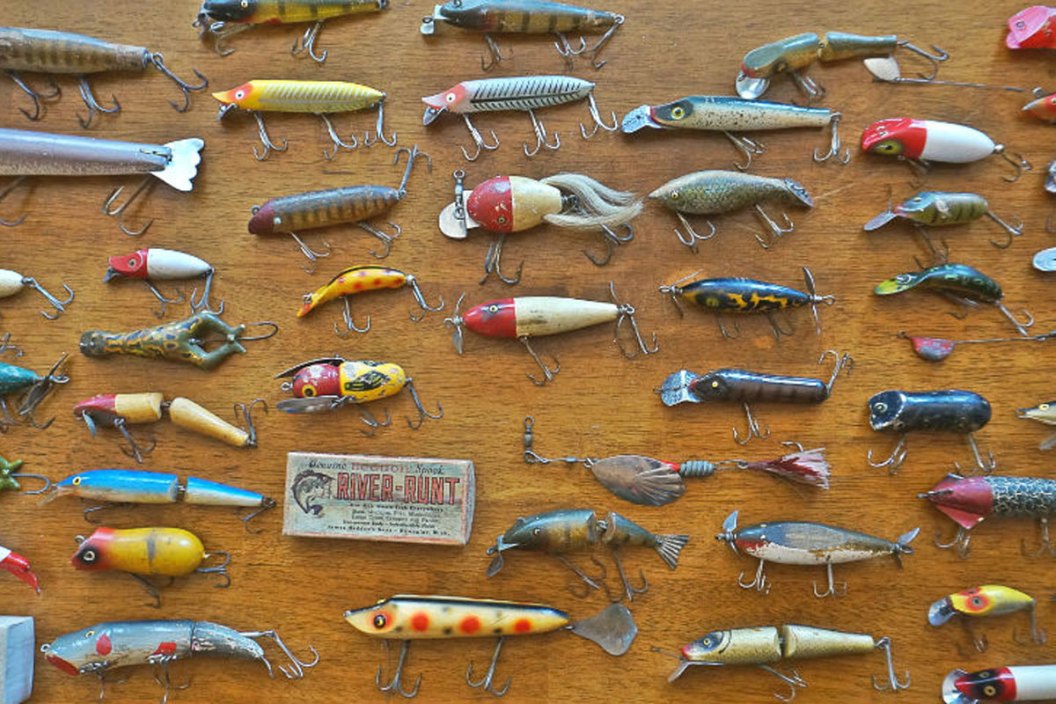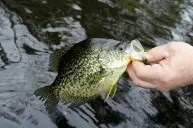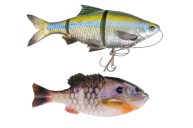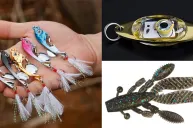Here are 10 vintage fishing lures that still catch fish (if you're brave enough to tie them to your line).
Collecting and even fishing with vintage fishing lures is a fun way to add to your angling experience.
Here are 10 antique fishing lures that might be in your dad's or granddad's tackle box.
Some of these are fairly common old lures, and some might be rarer finds that could bring a pretty penny or two.
1. Creek Chub Pikie Minnow
The Creek Chub Bait Co. is an antique lure collector's dream. Producing an incredible variety of lures with countless variations over more than 50 years, Creek Chub offers an almost endless well of opportunity for collectors of old fishing lures, enough so that there are books devoted to the lures.
The company's iconic offering was their Pikie Minnow, and it was so successful at catching both fish and fishermen that it's still manufactured today, albeit in different materials and in China. The original Pikie Minnow was a cedar plug with glass eyes and a metal lip and boasted upwards of 14 coats of paint and lacquer.
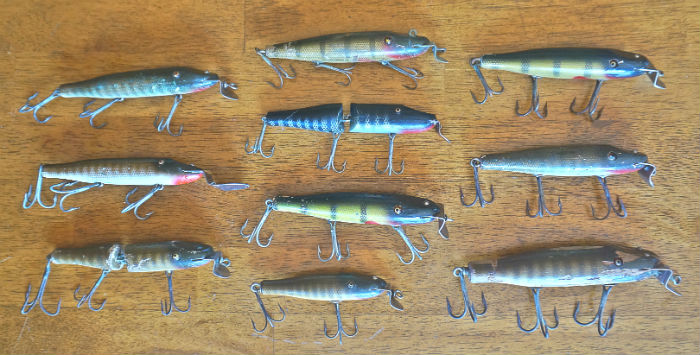
I'm betting almost every freshwater angler's tackle box from the 1900s carried at least one Pikie Minnow. Proven musky, northern, lake trout, and big bass catchers, these lures came in multiple sizes with a variety of finishes. So many were sold that it's fairly easy to find them today in mint condition with their original lure boxes.
Most can be had for well under $100, some sell for much more, and you can find many for around $15-$20. I've got an old beater Pikie Minnow from, I would guess, the 1940s that had most of the paint chipped off. I changed the hooks and repainted it, and it still catches northern pike and the occasional musky to this day.
2. South Bend Bass-Oreno
The Bass-Oreno might be my favorite lure of all time. It certainly has a lot of great memories of vicious strikes, big fish and wonderful locations associated with it.
Great for big bass and an absolute northern pike killer, the Bass-Oreno can be twitched as a topwater lure or retrieved as a swimming lure. It's smooth zigzagging motion on the retrieve has triggered many a pike and bass to hit it like a freight train.
James Olds of Benton Harbor, Michigan, patented the Wobbler in 1915 and then immediately sold that patent to the South Bend Bait and Tackle Company. South Bend began producing the Wobbler in 1916 before quickly renaming it the Bass-Oreno.
It went on to become the company's best selling lure and has been dubbed by some as the greatest topwater lure of all time. It's a wonder no one produces it today.
While millions of Bass-Orenos were sold — red and white was the most popular color scheme — there have been many variations of the lure during its lifetime. Luhr Jensen purchased the rights to the Bass-Oreno in 1982 and was the final bait company to produce the it.
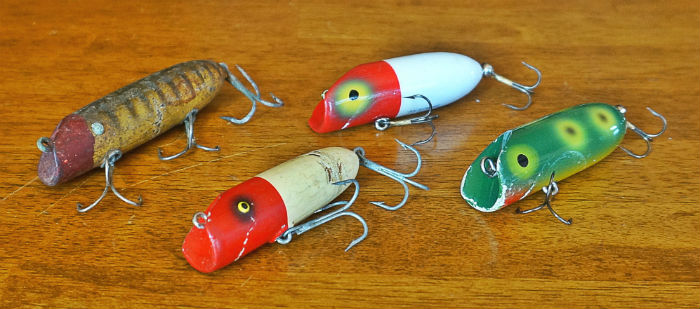
Most Bass-Orenos can be purchased for around $10, but depending on the usual collectible factors (maker, color, rarity, number produced, etc.), some sell for much more.
For example, if you happen to have an early 20th century Bass-Oreno in the patriotic red, white and blue colors, you might have a lure worth several hundred dollars on your hands, or even upwards of $1,500 if it's in good condition. These limited edition Bass-Orenos were apparently made to celebrate the end of World War I.
A couple years ago, I was able to purchase several Luhr Jensen Bass-Orenos from a trade show for the unbelievably cheap price of $1 each. I always have a couple in my tackle box and use them often. They never disappoint.
3. Roberts Mud Puppy
The C.C. Roberts Bait Co., makers of the original Mud Puppy big fish lure, is still in business producing this unusual lure. These days the company is owned and the lures are made by James Rheinschmidt Jr. The original Mud Puppy was created in 1917 in Mosinee, Wisconsin.
The story goes that Roberts got the idea for his topwater, tail-spinning lure after watching a musky chase a salamander in the shallows of the Rib River. He was also dismayed anglers often lost muskies as the fish violently shook their heads during a fight, sending the lure "sailing skyward." So he engineered the Mud Puppy with detachable hooks.
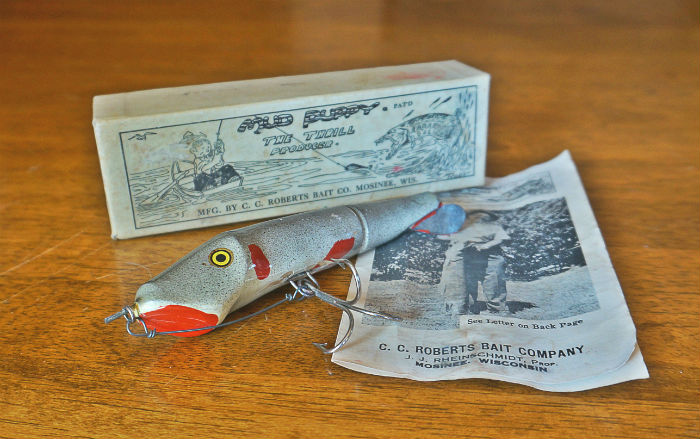
After a fish hits the Mud Puppy, the hooks come free of the lure. This allows you to fight the beast without giving it the advantage of leveraging the lure and throwing the bait. After you (hopefully) land the fish, you then retrieve your hookless Mud Puppy from the top of the water.
Given that brand new Mud Puppies are still on the market and sell for under $20, a vintage Mud Puppy is affordable to most anglers. You can generally get them for somewhere between $25 and $100.
New Mud Puppies are packaged in cardboard and plastic wall hangers. You can often find vintage Mud Puppy lures sold with the boxes they originally came in and with the little pamphlet C.C. Roberts included. They're even occasionally available on Amazon.
4. Heddon Luny Frog
The Heddon Luny Frog made its appearance around 1927 and was produced by the company until around 1932. Made of then-revolutionary pyralin, the material would largely replace Heddon's wood lures. The Luny Frog was, I believe, the first mass-produced fishing lure that used the hard plastic material.
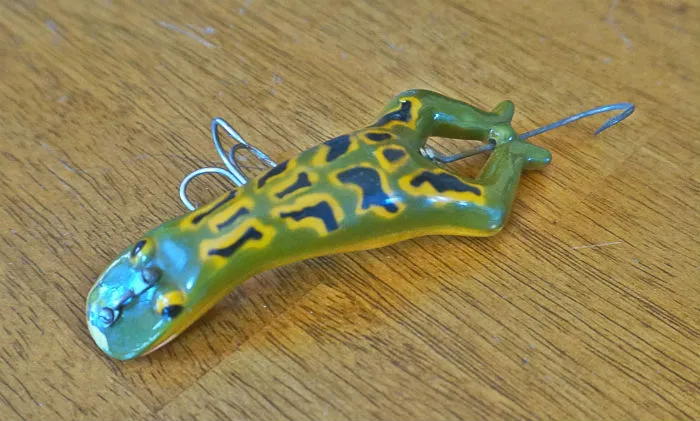
A killer on largemouth bass, the Luny Frog mimics a live frog in its action. I have a couple Luny Frogs, one of which has its original "toilet seat" hardware missing and is in pretty rough shape. I occasionally like to securely tie this one on and cast for spring bass in the shallows, especially if I'm using an old fiberglass rod equipped with a vintage Ambassadeur 5000 baitcasting reel.
Truthfully though, after one bass, I usually untie it and place it back in my tackle box. Rough shape or not, I don't want to push my luck on losing this great antique fishing lure.
There were actually two models of the Luny Frog - the open-leg version shown here and a closed-leg model. If you happen to have one of the rarer closed-leg models, you could be looking at a lure worth anywhere from $100 to over $1,000, depending on condition. You can pick up Luny Frogs for sale online in decent condition for around $40, although occasionally cheaper deals can be found.
Check out this 1928 Heddon catalog page featuring the Luny Frog shared by FinAndFlame.com.
5. Creek Chub Mouse
The Creek Chub Mouse is my dad's favorite topwater lure for big pike and largemouth bass. He has many of them, made of the hard plastic that characterized Creek Chub's production in the 1960s and 70s. He fished them hard - so hard most of their hair and string tails are missing and they've all got battle scars from pike teeth.
They're a buoyant, fat little plug that sits smartly on the water, bobbing with the action an angler gives it. In truth, I could never get the hang of fishing with a Mousie, as we called them. But they were immensely popular in the 1960s. It seemed like every company had a mouse lure in its catalog, including Shakespeare, Heddon and Herter's. And my dad bought them all.
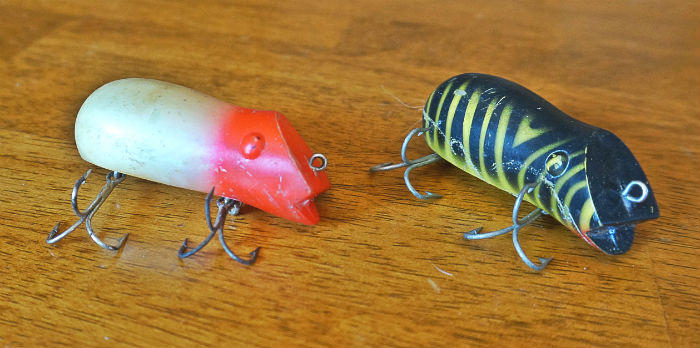
Today you can get mouse lures so realistic that they look like they were molded from actual mice. If you want the older version, most can be had for under $20, even with glass eyes.
My dad doesn't fish very much these days at his advanced age, but when he does get out on a lake and targets the shallows in the early morning, he still ties on a mouse. And he usually still ends up fighting a pike or largemouth bass to the boat.
6. Heddon Flap Tail
Introduced around 1935, Heddon's Flap Tail (or Musky Flap Tail) lure was a good seller, although it seems curiously forgotten today.
Relatively small for a musky lure at only five inches in length, the "mouse" finish Flap Tail displays a furry body and has small ears and whiskers. These models are very collectible.
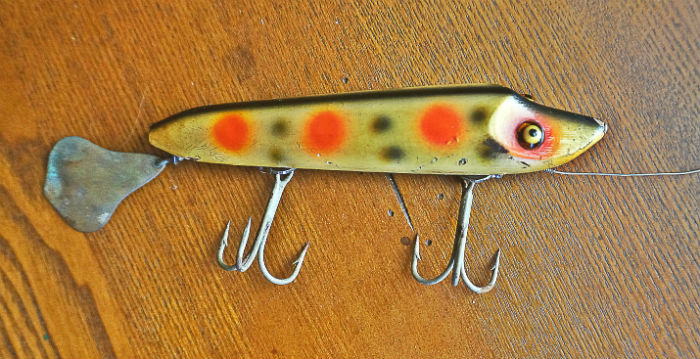
The lure came in six other paint schemes. The Flap Tail also came in a Junior model, which was half the size of its larger brethren, and a Standard 4-inch model. This lure works well on musky and pike. But it also made a name for itself catching big striped bass.
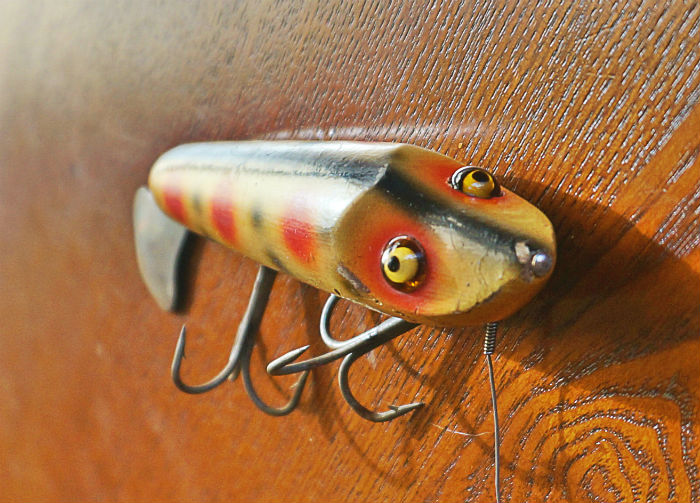
Back in the day, originals sold for $1.25. Today you can find them on eBay for around $20 or so. Unusual paint jobs like the mouse finish will bring more. I wouldn't fish with one of those, but in my opinion the relatively inexpensive price of most other Flap Tails more than justifies the experience of casting this vintage 1940s musky or pike killer.
7. Eppinger Dardevle
Eppinger is one of the oldest still-producing fishing lure companies in the world. Lou Eppinger started officially selling his unique spoon lure, dubbed the Osprey, in 1912. But its origin began about six years earlier when he was fishing in Ontario and got fed up his line twisting from the spoons he was casting.
Eppinger decided to improve on the design, so he began hammering metal until he got a heavyweight spoon that was thinner in the middle than on the edges. Rather than a line-twisting spinning motion, this design gave the spoon a unique wobble when retrieved.
They eventually changed the name of the Osprey to Dardevle, in honor of the Marines of World War I. They also added the devil's head logo to set theirs apart from the competition.
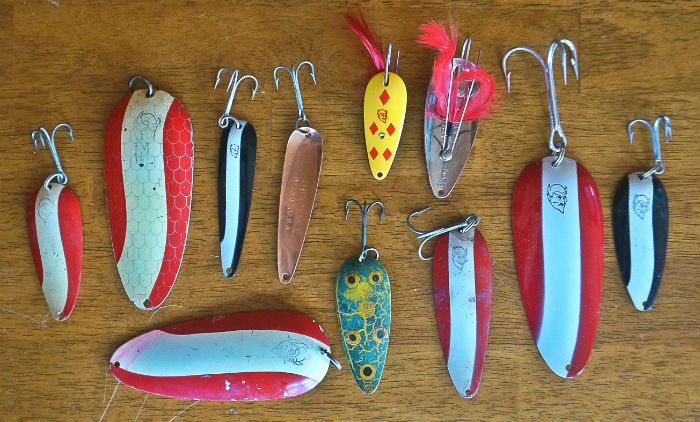
Today the company produces more than 16,000 varieties of their famous lure, and they sell around a million every year. Their top seller continues to be the iconic red and white spoon. Everything is made by hand and made in America. And they continue to catch virtually every fish that swims.
You're not going to get rich selling your vintage Dardevles. They are very affordable, even the early ones. But you might make a few bucks if you happen to have an old, vintage box those early lures were packaged in. The boxes are rarer than the famous spoons they held.
8. Vintage Spinner Lures
Old spinner baits are kind of a special category of vintage lures. They've been around ever since some enterprising angler attached a shiny piece of metal to a hook.
They've stood the test of time and continue to be one of the most universal fish catching lures ever invented. If you happen to unearth any late 1800 to early 1900 spinners you may not want to use them, even though they will surely still work at attracting fish. Modern spinners have dramatically improved on the older, heavy spinner format.
Granted, most do not have a great monetary value, as they lack the character and heft of plug-type lures. Plus they were very common, and there are a lot of them out there.
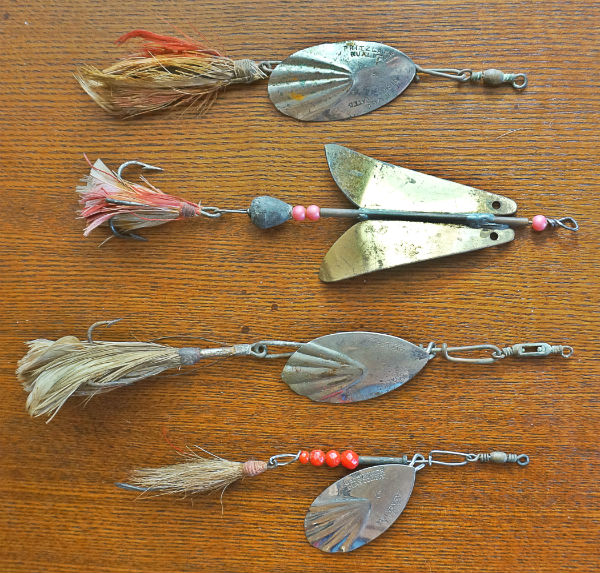
Let's take a quick look at one vintage spinner manufacturer.
The G.M. Skinner company of Clayton, New York exclusively made what they called "spoons" and we today call spinners. Gardiner Mills Skinner (b.1845) and his wife Marianne moved from Ontario to New York, where Skinner opened the G.M. Skinner Fluted Spoons company and continued to design award winning fishing lures until his death in 1903.
Almost all of Skinner's fluted spoons bear the date of his first patent — 1874 — which was awarded to him for his Fluted Trolling Spoon. This date sometimes confuses would-be collectors into thinking their spinners are older than they actually are. But this practice continued into the 1970s.
If, however, you have a G.M. Skinner fluted spoon/spinner with any other date (there were a couple of brief exceptions to the rule) or a spinner attached to its sales card, you do indeed have a rare and valuable find worth several hundred dollars.
9. Heddon Vamp Spook
The Heddon Vamp was first introduced in 1920, when Heddon's lures were still made of wood and had glass eyes. The Vamp remained a very popular lure for the company for over 50 years and was particularly deadly on pike, musky and bass. The Flap Tail, mentioned above, was basically a Vamp lure with an added metal attractor added to the tail.

Although Heddon began introducing plastic lures before the 1950s, it was during that decade they began to really predominate the company's production. The Vamp Spook was so-called because it was made of a hard, clear plastic you could see through, like a ghost.
There are a ton of Vamp Spooks on the market and prices vary wildly. Most run in the neighborhood of $20-$30, with a few special colors schemes and sizes bringing more. If you've got an original box to go with the lure, you can expect to double the price. But you can still find some in great condition that are priced ridiculously low, so buy them up and use them! They are a fantastic lure.
10. Helin Flatfish
The Helin Tackle Company started in 1933 in Detroit, Michigan but eventually transferred operations to Canada. Charles Helin invented the Flatfish lure, which was the foundation of his company. By 1971, Helin could boast of selling 40-million lures. Every tackle box in America seemed to hold a few Flatfish.
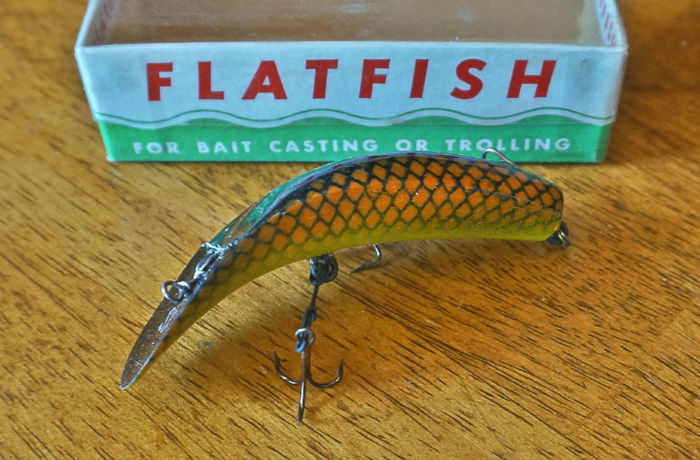
Today there's really no need to fish with an original Flatfish, unless you're a discerning angler who can tell the subtle difference in action between wood and plastic. Original Flatfish were made of wood, but Helin soon moved to plastic. The company sold Flatfish in 21 models and 37 color options.
These days Flatfish are manufactured by the Yakima Bait Company. They come in a multitude of sizes and colors, designed to catch everything from panfish to walleye, pike, salmon and trout.
Flatfish have, in my opinion, been largely and curiously ignored by the collecting community. You can still find original Flatfish, with their boxes and papers, for criminally cheap prices. Don't expect this situation to last, though. I have a feeling that soon the fishing tackle collecting community is going to catch on.
Products featured on Wide Open Spaces are independently selected by our editors. However, when you buy something through our links, we may earn a commission.
All images from the author except where otherwise noted.
NEXT: STICKBAIT FOR BASS: 4 WAYS TO RIG THE SOFT-PLASTIC FAVORITE
